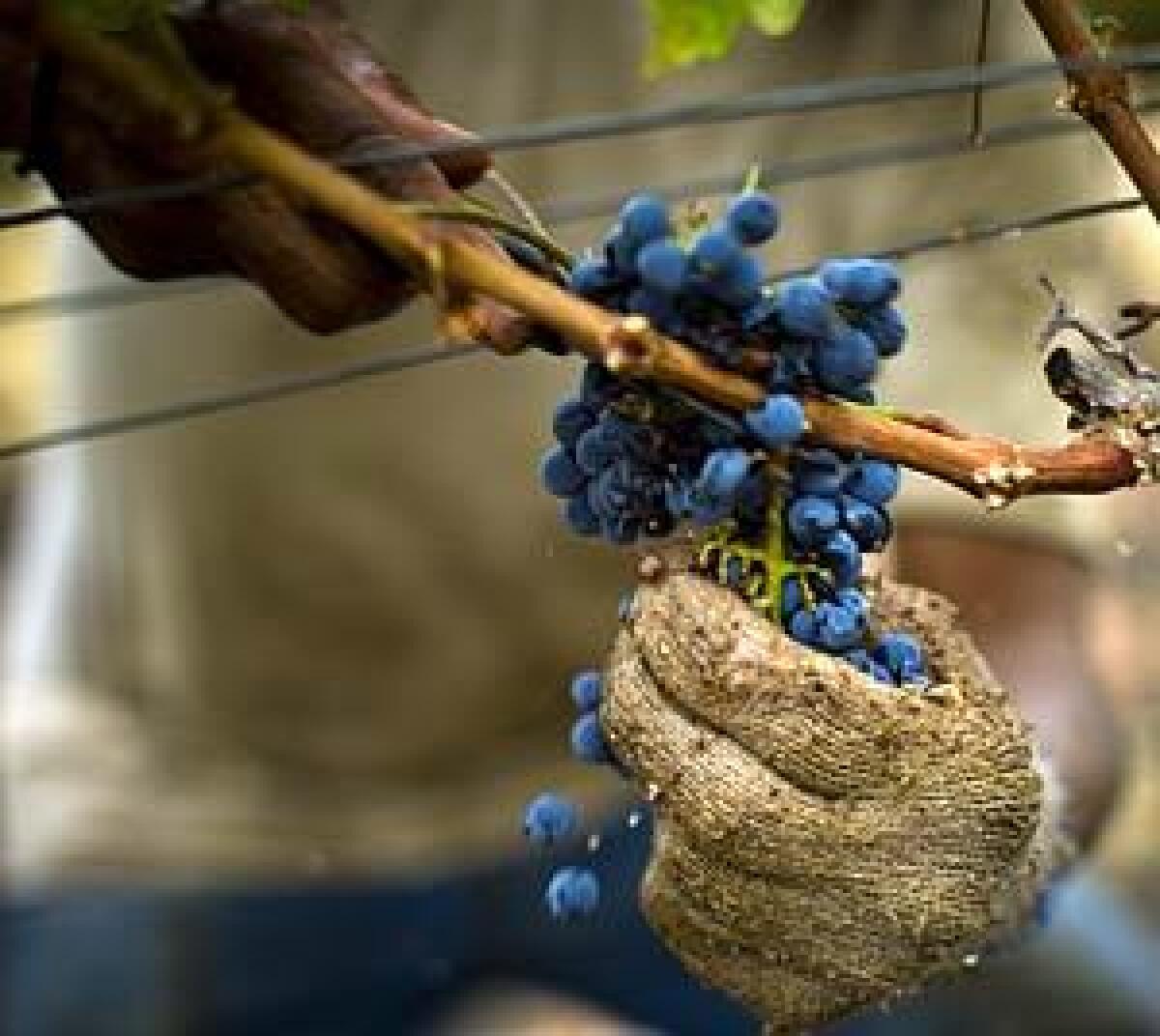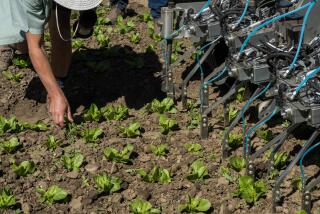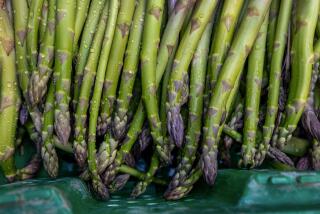In Napa, deus ex machina?

NAPA — Napa Valley vintners had already started buzzing about a promising 2007 vintage when Aug. 27 dawned and pandemonium broke loose. Temperatures soared above 95 degrees and stayed there for 10 days. Irrigation systems across the valley were cranked up high to pump water into grapes that otherwise would have turned to raisins. Harvesting whatever was ripe as fast as they could, every available crew worked from midnight to noon without a day off.
Then, as suddenly as the crisis started, it was over Sept. 7. The weather cooled, and the irrigation flow returned to its usual harvest-time slow drip. In keeping with Napa Valley’s signature bravura, the buzz about a stellar vintage resumed. The word in the vineyards? This last week of unusually cool days with lingering September morning mist is allowing the extraordinarily small berries in this year’s lighter-than-expected crop to finish ripening slowly. It should be a remarkable Napa vintage, perhaps the best in a decade.
Still, there is a sense of unease in Napa. This season there were enough vineyard workers to harvest the precious crop, despite concerns there would be labor shortages as a result of the ongoing efforts to tighten the U.S. border with Mexico. Although there is no official count, vineyard managers say the vast majority of temporary workers that arrive for the fall harvest are in this country illegally. And they aren’t certain that those workers will be available in the future. Obviously, the workers are anxious as well.
“We’ve been [hiring people] with a wink-wink, nod-nod on documentation,” says Sam Turner, owner of Vista Vineyard Management. He and other vineyard managers say that if pending regulations making employers responsible for verifying the legal status of their workers take effect, they won’t be able to continue playing that game.
There are two times of the year when Napa Valley relies on temporary workers. During August, September and into October, those workers are vital for harvest. And in January, February and into March, temporary workers provide the extra hands necessary for pruning the vines, a less time-sensitive job that can be stretched out over a longer period of time.
In America’s premier wine region, the timing of harvest is impossible to predict and requires a large, instantly available workforce. Crews use small, curved knives or clippers to cut individual bunches of grapes from the vines. Moving up the vine rows, they fill small bins with grapes that they will toss into half-ton bins, being careful not to smash the grapes (“berries”).
Some vineyard managers hire larger harvest crews that work with 6-inch-deep, stackable grape bins. By not tossing the grapes into larger bins, they intend to further ensure that the grapes arrive at the winery whole, unbruised and less likely to become infected with bacteria from the field.
During the last decade, each evolution in the understanding of the best process for harvesting premium grapes for Napa’s sought-after wines has meant more workers in the field and more hands gently moving the fruit from the vine to the fermenter. But all that may change. “If the government goes after employers to enforce the immigration laws, everything will shift to mechanization,” Turner says.
Although half of all of the wine grapes in California are harvested by machine, less than 10% of Napa’s grapes are harvested mechanically, vintners estimate. The stigma of industrial farming plus a clear sense that quality demands hand-harvesting has kept most vintners from considering it. That’s changing, however, with concerns about a labor shortage. A surprising new clutch of ultra-premium wineries this year used mechanical harvesters, if only on an experimental basis.
Mechanics of a harvester
A 20-foot-high machine straddles a row of vines at Clos Du Val in Stags Leap District. It’s narrower than a combine, but its bulk and deafening noise are the hallmarks of industrial farming. Internal hoops vibrate against either side of the vine row, shaking fruit down onto conveyor belts that lift the fruit up to an arm that spews it out into a trailing 2-ton fruit bin. The mechanical harvester moves at a steady pace, the equivalent of a slow jog for any worker on the ground, not stopping until it reaches the end of the row.
One person drives the harvester, and two workers maneuver a pair of tractors pulling fruit bins. Any obvious green fruit and raisiny bunches have been removed by hand the day before in a preharvest pruning. Leaves are blown out the back of the machine.
Unlike the mechanical harvesters available a decade ago that used sticks to knock the fruit onto the conveyor belts and damaged the vines, these machines can be calibrated to gentler vibration levels. The vertical trellising systems popular with high-end Napa vintners are best suited for mechanical harvesters.
When the harvester is finished with a row, most of the stems remain attached to the vine, the berries literally shaken off them. At the end of harvest, the fruit bins are filled with a mix of whole berries, crushed fruit and juice along with only a few stems. What the process lacks in romance it makes up for in economic sense. It costs $150 an acre to machine harvest grapes, according to Clos Du Val calculations. Harvesting by hand costs $600 or more an acre.
Mechanical harvesting works well for the thicker-skinned Bordeaux grapes of Merlot and Cabernet Sauvignon, says John Clews, Clos Du Val vice president for vineyard and winery operations. His winery is the rare Napa winery to invest heavily in mechanical harvesting, gradually increasing the number of acres harvested mechanically for the last 20 years. Clews sees a quality advantage because the grapes, de-stemmed by the machine in the field, can be processed more quickly in the winery.
Pinot Noir and white grape varieties are a different story, he says. Mixing the white grapes and the juice in the bin after mechanical picking allows prolonged skin contact with the juice that can oxidize the wine. Pinot Noir is too thin skinned and delicate to survive the process without degrading the wine, Clews says. Clos Du Val’s white grapes and Pinot Noir are picked by hand, at night, under lights.
“If the government ever really cracked down, if they make us be the cops, we’ll mechanize because we have to,” says Bo Barrett, winemaker at Chateau Montelena in Calistoga.
Without an inexpensive labor force available for hand harvesting, Australia and New Zealand rely solely on machines, and most of the grapes in Bordeaux are mechanically harvested. So some vintners are reconsidering the machines. “The technology has been demonstrated to our satisfaction by the top Australian wines,” Barrett says. “These wines are getting 95 points and higher from Robert Parker.”
In 1985 when he experimented with mechanical harvesters that relied on sticks instead of vibrating hoops, Barrett says, “it was just ugly, really tore up the vines.” This year, Barrett harvested one Merlot vineyard with a machine calibrated to his specifications. “It really shook up the vines but didn’t seem to hurt them,” he says. “We’ll know more about the effect on the vines when we prune in the spring. But the fruit looked gorgeous, primarily whole berries and much less juice than we expected. We could still sort the fruit.” After blind tasting the different lots of Merlot in January, he says, he’ll have a better idea of the effect on quality.
Quality is everything
The possibility of even a slight reduction in quality has Duckhorn Wine Company skittish about mechanically harvesting, says Bill Nancarrow, Duckhorn’s executive winemaker. “I wouldn’t mind using them,” says the New Zealander who had experience in his home country with mechanical harvesters. “When your vineyards are near your winery, it’s like presorting in the field. But we’ve become so focused on how we handle the fruit, all of this gentle handpicking and sorting. It’s an obsession in Napa.”
So is mechanization a major threat to vineyard workers’ livelihoods? Actually it’s not. Although some vintners are experimenting with machines, it’s not the way they prefer to harvest. In fact, it’s the immigration issues that are threatening workers. “Crossing the border is very, very hard now,” says Jacobo Perez, supervisor of the harvester crew working in the Clos Du Val vineyard, who is very concerned about his workers’ safety. “My workers are very, very worried” that they will not be able to continue to work in Napa.
Before dawn last Wednesday, a crew of eight workers was picking Cabernet Sauvignon in Cliff Lede’s Poetry Vineyard, a hillside block of vines in Stags Leap District. Vineyard manager David Abreu, well-known for his work with cult Cabernet vintners including Ann Colgin, Bryant Family Vineyard and Staglin Family Vineyard manages this vineyard as well. He insists his workers harvest grapes into shallow yellow boxes that are half the size of regular harvest boxes. The grapes are left in those boxes until they are turned onto the sorting table at the winery.
The crew runs back and forth from the vine rows to a specially made trailer where they stack the boxes. It takes 45 minutes to harvest one acre. But the kid-glove treatment is worth it, says Cliff Lede winemaker Michelle Edwards. The fruit arrives in pristine condition at the winery, where it goes into a cooler until it is ready to be sorted and de-stemmed before fermentation.
Edwards looked at mechanical harvesters recently and was impressed. But Cliff Lede Vineyards will be one of the last to mechanize harvest, she says. It’s the opposite of everything the winery has been doing to improve quality. “I hope it doesn’t all go to mechanization,” Edwards says.
The same refrain can be heard from other vintners concerned that even if any quality diminution is slight, it would undermine their efforts to make the best possible wines.
Jason Kesner, vineyard manager at Hudson Vineyard in Carneros, picks his 180 acres of mostly Chardonnay and Pinot Noir at night and by hand because that’s what Patz & Hall, Kistler and the other winemakers who buy the fruit want, he says.
The only way he thinks he can ensure he has enough workers next year to deliver the fruit his customers want is with full-time crews. Last year, he gave his workers an across-the-board 12% raise to discourage them from leaving to work for another grower. Hudson Vineyard bought an apartment building in Napa to offer subsidized housing for the crew to complement the medical and dental benefits they get. “It’s very competitive to keep good workers,” Kesner says.
Entry-level seasonal workers in Napa are paid $10 an hour. On average, full-time workers make $13 to $16 an hour over the course of the year, according to a labor survey by the Napa Valley Grape Growers Assn. During harvest, permanent workers are paid up to $25 to $30 an hour, according to vineyard owners.
“The stakes are so high in Napa,” says Turner, who manages 850 acres of vineyards through Vista Vineyard Management. Certainly, more of his customers are experimenting with mechanical harvesting. But if they determine it reduces quality, they won’t do it, he says.
Napa pays higher wages than any other California agricultural region, so vintners here think they’ll have access to whatever workers are available in the state, regardless of the immigration laws. “If vintners have to pay 50% more for labor,” Turner says, “it’s not going to make any difference to them.”
More to Read
Sign up for The Wild
We’ll help you find the best places to hike, bike and run, as well as the perfect silent spots for meditation and yoga.
You may occasionally receive promotional content from the Los Angeles Times.










